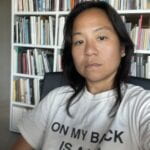What is the place of critique in the art world? How does the Berlin (art) scene differ from the one in, let’s say, New York? Is there such a thing as diasporic aesthetics? Cecilia Bien talks about that and a lot more with Nina Katchadourian
Nina: So you’re sick of critique.
Cecilia: In 2023 it feels like there’s an overwhelming amount of the same kind of skepticism toward institutions and we all already know the problems. That’s a problem because the solution seems to default to programming that fits the script of how to orchestrate identity politics. There’s already an absorption by global institutions, and then the critique that follows all sounds the same.
Nina: But I think you’re also sick of the way that the art world often wants to check the boxes of a certain set of formulas or correct actions, and of how predictable all this can be. And therefore maybe there’s excitement around what isn’t squarely within the art world, as you’ve said, what is not yet described as ‘art’. I think that’s really fascinating. Does that mean that you’re kind of trying to catch something before it gets codified?
I’m interested in what is not yet framed as art. I’m interested in attitudes, the impulse.
Cecilia: I’m interested in what is not yet framed as art. I’m interested in attitudes, the impulse. I am thinking about how to show ‘marginal’ work in a contemporary context without the feeling of it being used for representation, or shown in a way that has to be overexplained. What are the conditions? Maybe the answer is outside of cultural production and the art world. Fashion and music seemed to embrace ‘other’ perspectives earlier, maybe it was easier because those industries are more obviously linked to capitalism, like it is clear they exist to make money, so because the exploitation is more obvious there isn’t so much space to critique those forms of production. I am not sure.
Nina: How did you end up in Berlin?
Cecilia: I came on NYU’s Global Research Initiative fellowship to study how culture emerges from a different geopolitics, namely a different conception of the east-west binary, and then how it’s represented in institutions. Three months turned into three years and counting. Maybe this prolonged sojourn sounds cliche, but I started working directly after my studies in ways I was already thinking and writing about. I’ve experienced firsthand the institutionalization of collectivity in my work places here, and being here let me think from a different perspective about things like diaspora and how movements gain traction.
Nina: What are the differences or similarities you see in, for example, fashion, style, or haircuts, or how people walk down the street, when you compare Berlin to New York?
Cecilia: Reference to club culture doesn’t happen in the same way in New York as it does here. Fashion in Berlin subscribes way less to trends in favor of individuality even if it’s ugly. I find that refreshing because maybe it means that the hierarchy of taste is always being questioned. There are different codes here, a lot of the styles in Berlin seem to be more lived. Here I also see how subcultures can complicate expectations of diaspora. On the flip side, I feel like a lot of what gets absorbed by the cultural industry in Berlin is appropriated from what’s been happening for a while in New York.
Nina: We’ve talked in a lot of different contexts about when something from the periphery gets absorbed into the mainstream. I think you have a good antenna for this and that it’s deeply interesting to you. How can you tell when something like this is happening?
Diaspora is so layered and complex but it seems to be becoming a euphemism for a certain kind of woke taste.
Cecilia: Recently I’ve been focusing on when and why certain tastes change. When an incisive political message gets diluted, the aesthetics attached to it become normalized. I think about what the term ‘diasporic aesthetics’ means to people who understand things through representation. Diaspora is so layered and complex but it seems to be becoming a euphemism for a certain kind of woke taste different enough from the norm, but only with a certain kind of difference being accepted; it cannot feel bourgeois, but it must be digestible, though not necessarily understood, and appreciated without being deemed as trashy. When I hear such aesthetics embraced as beautiful I wonder what makes them so, and which cultural tides had to change or switch course to be considered this way.
Nina: I’ve always known you as someone who thinks from two positions: you’ve been a maker, but also a critical analyst of systems and institutions. When you think from those two positions does one enhance one another? I know you’ve recently done some work as a curator, do you think curating is a type of making?
Cecilia: I think it can be because it’s a way to conceptualize, the making of an idea. I guess curating is also the making of an exhibition or making of an argument. That said, making an exhibition about a so-called diasporic group does not count, for me, as the making of an argument. For example I am no longer Asian American outside of America. At least this is how I feel I am perceived here. There are countless versions and political positions and reasons why people move from place to place so how can you group them all by a prescribed cultural background? It’s quite superficial, and certainly not enough to base a concept on.
Nina: What are some examples of an exhibition addressing a ‘vague diaspora,’ and when do you think it works and when do you think it doesn’t?
Cecilia: A lot of times these exhibitions are accompanied by super research-based texts, which I often have a hard time with, even though I also write some myself. I’m often not sure what the relationship should be to the artwork, like whether it should exist in parallel as a complementary work or whether it should walk the viewer through, because a lot of times it is hard or impossible to place the work in an art historical context or within a canonical framework, which is what many viewers going to a museum or institution are used to and might even expect. The curatorial choices for non-western art are also still often from a western-educated lens.
So these rather heavy handed texts might be trying to contextualize the works in a new temporality but often come off as a dry justification of why the work is allowed to be there. There’s something slightly insecure in the overcompensation, and it feels a little like it’s not completely sure of what it should be doing.
I work at an archive that is a collection of people globally reacting to and rejecting the canon and art history
At the moment I work at an archive that is a collection of people globally reacting to and rejecting the canon and art history, a global network which came to be called Fluxus. In Prague, Milan Knížák’s ‘actual walks’ considered everything between how to wear a garment, how to walk down the street, and how to interact provocatively. This kind of work is impossible to pin down as an art object or as something that can be placed in a museum, or something understood purely by looking.
So it’s interesting to try to give these works significance without placing them in categories structured by a hierarchical order. Every day we deal with questions of how to contextualize collective action outside of art history, how to show what is not necessarily called art, as art, and whether we should do it at all when most of what was created was ephemeral and meant for impermanence. But I still want to curate a show with Knížák’s drawings and sketches, and correspondences between the artists in the collection, as a way to show the very attitude that we’re talking about right now.
Nina: I love that idea. And why is this particular approach to curating interesting to you?
Cecilia: For me it is related to understanding how attitudes become form and why certain aesthetics become centered in the cultural field. The cultural field, as a professional field, works for me in the sense that it doesn’t take itself for granted, or it does not take long to recognize when it does. There’s always space to challenge itself. I like that one can have conversations about skateboarding, graffiti, burlesque, bad fashion, and there’s always a locus for it; for example, when does counter-culture become just straight up culture? What eventually gets counted as art? Will memes count in art history later?
Nina: Do you follow the Instagram account @arthandlermag? I love it because it’s a combination of fantastically intelligent practical tips, but it’s also about labor. There are a lot of insights from people working in the field, who are usually artists, and the bigger system around them is often what gets revealed.
Cecilia: Yes exactly, there’s a self-awareness of many artists today participating in the labor market in a way at odds with their values. I like how these inside jokes sniff out the contradictions in being involved in the art world as a laborer while simultaneously pursuing an honest career within it. It’s not exactly critique, but more of a nod, ‘if you know you know.’ The fact that it happens on the same platform that institutions and galleries use to promote themselves is a lovely reminder that there will always be counter-networks and sleight of hand insurgencies running parallel, or at least in relation, to the dominant narrative.

*Cecilia Bien writes and organizes programs in Berlin, for artists as well as para-institutions such as SAVVY Contemporary and Archivio Conz, a Fluxus archive. Previously working in applied art and fashion contexts in New York City, she came to Berlin to complete studies in art and cultural theory, recenter her critique of dominant narratives, and understand her own subjectivity outside of an identity politic tied to living in the US. Her current practice concerns diasporic aesthetics and situating play, chance, and community coming from the periphery in the context of art.

**Nina Katchadourian is an interdisciplinary artist whose work includes video, performance, sound, sculpture, photography and public projects. Her video Accent Elimination was included at the 2015 Venice Biennale in the Armenian pavilion, which won the Golden Lion for Best National Participation. In 2016 Katchadourian created Dust Gathering, an audio tour on the subject of dust, for the Museum of Modern Art. A traveling solo museum survey of her work entitled Curiouser opened in March 2017 at the Blanton Museum of Art and toured to the Cantor Art Center at Stanford University in fall 2017. It will conclude at the BYU Museum in Provo, Utah in March 2018. An accompanying monograph, also entitled Curiouser and edited by curator Veronica Roberts, is available from Tower Books. Katchadourian’s work is public and private collections including The Metropolitan Museum of Art, Blanton Museum of Art, Morgan Library, San Francisco Museum of Modern Art, Margulies Collection, and Saatchi Gallery. She has won grants and awards from the New York Foundation for the Arts, the Anonymous Was a Woman Foundation, the Tiffany Foundation, the American-Scandinavian Foundation, and the Nancy Graves Foundation. Katchadourian lives and works in Brooklyn and she is an associate professor on the faculty of NYU Gallatin. She is represented by Catharine Clark Gallery, San Francisco, and Pace Gallery, New York.